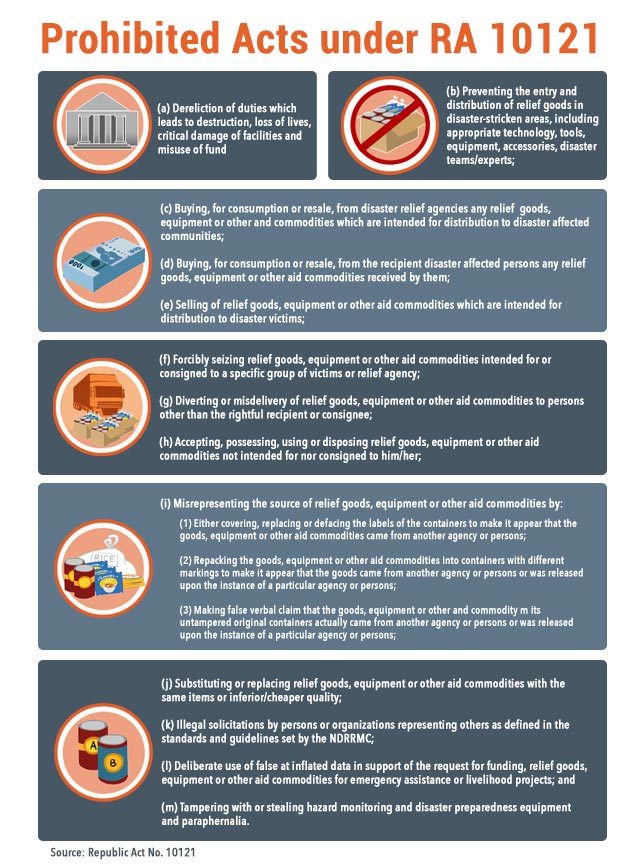SUMMARY
This is AI generated summarization, which may have errors. For context, always refer to the full article.
MANILA, Philippines — As Republic Act No. 10121 turns 5 this year, the congressional oversight committee is conducting a “sunset review” of the law.
Republic Act No. 10121, known as the Philippine Disaster Risk Reduction and Management (DRRM) Act of 2010, is an act mandated to strengthen disaster management in the Philippines, a country prone to natural hazards.
Signed on May 27, 2010, it aims to develop a framework and roll out resources that will enable the national government, the local government units, and other stakeholders to build communities that can survive disasters.
RA 10121 repealed Presidential Decree 1566 that created the National Disaster Coordinating Council (NDCC). This changed from the NDCC to the National Disaster Risk Reduction and Management Council (NDRRMC) as the overseeing body.
It also emphasizes strengthening local governments and the importance of local communities. It institutionalizes the participation of civil society organizations (CSOs) and the private sector.
Five years into implementation, RA 10121 is due for evaluation by the congressional oversight committee. In consultation with sectors and agencies, the committee will assess the performance and organizational structure of implementing agencies.
Here are the basic features of the law that they will be looking into.
Strengthening the DRRM System
RA 10121 makes sure that policies and plans are in place to prepare communities for when disasters strike. Programs should increase awareness and knowledge of risks and hazards, and preparedness for effective response and early recovery.
RA 10121 empowers regional and local disaster management bodies in terms of responsibilities and funding.
The regional DRRM councils are tasked to coordinate, supervise, and evaluate the activities of provincial, city, and municipal DRRMCs.
Given that there will be a huge number of councils in the regional and local levels, the main coordinating body will be the NDRRMC. The Office of Civil Defense (OCD) helps in the implementation of activities. (Read: FAST FACTS: The NDRRMC)
Providing framework
In making sure that we are prepared for any disaster, the NDRRMC is to formulate a working framework centered on preparedness and reducing damage as well as casualties.
RA 10121 says that the framework should be comprehensive — addressing different sectors, has synergy with other agencies and most of all takes into consideration the voice of the community.
It shall be the principal guide to all DRRM plans and activities in the country. The framework shall be reviewed every 5 years.
Following the framework, the National DRRM Plan should contain goals and objectives in disaster mitigation. It is the task then of the OCD to formulate and to implement this plan.
As this function is also decentralized to the local level, it is their duty to design and integrate their own local plans according to national, regional and provincial frameworks and policies.
Appropriation of funds
The President approves the funds for the NDRRMC. The OCD, on the other hand, has been allocated P1 billion under RA 10121.
Local governments are to set aside at least 5% of their estimated revenue from regular sources for their disaster management councils. (Read: How do you use your local disaster funds?)
Of the local disaster management fund, 30% shall be allocated as Quick Response Fund, while the 70% shall be used for pre-disaster measures. During the onset of a typhoon, the QRF serves as a stand-by fund for relief and recovery programs.
The money may be used on pre-disaster preparedness programs, such as trainings, equipment, supplies, and medicines. Premiums on calamity insurance may be paid for post-disaster activities.
Unexpended LDRRM fund shall add up to a Special Trust Fund for the purpose of supporting DRRM activities of the LDRRMCs within the next 5 years.
Penal clause
The following are acts that are prohibited by the law, with corresponding penalties:

Violators of the law shall pay a fine of not less than P50,000 or any amount not to exceed P500,000.
In the instances of imprisonment, the convicted shall stay in prison for not less than 6 years and 1 day to more than 12 years.
If it’s a corporation or an association that is found guilty of , the penalty shall be imposed to its officers. License or accreditation of the body or the officers may be revoked as well.
This also includes perpetual disqualification from public office if the offender is a public official.
Foreigners who have committed the prohibited acts are to be deported without further proceedings in addition to the penalties of RA 10121. – Rappler.com
Source: Republic Act No. 10121
Add a comment
How does this make you feel?
There are no comments yet. Add your comment to start the conversation.